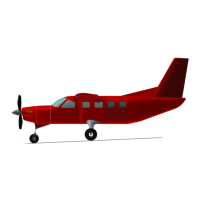ELECTRICAL POWER SUPPLY MALFUNCTIONS
Loss of Electrical Power
For increased redundancy, the electrical system includes two 24 volt batteries,
a starter/generator and an alternator, all of which may provide electrical power
to the master control unit. If one or more of the power sources should fail,
the remaining operational power source(s) is capable of providing sufcient
electrical power for most situations. If the
VOLTAGE LOW annunciation
should appear on the PFD, the EICAS page should be cross referenced
to determine bus voltages. If there is an actual system malfunction,
nonessential electrical equipment on the malfunctioned bus should be turned
off and a landing should be made at the nearest airport to determine the
cause of the problem before further ight.
3-5 INADVERTENT FLIGHT INTO ICING CONDITIONS
Flight into known icing conditions is prohibited unless the aircraft is equipped
with the complete “ight into known icing equipment package” and all
of the equipment is operative. However, during ights into Instrument
Meteorological Conditions (IMC), icing conditions may be encountered
inadvertently, and action should be taken to exit those conditions as soon as
possible. Initiation of a climb is usually the best action to take for avoiding
icing. Course reversal and accomplishing a descent into known warmer
air are viable alternatives. If ice remains on the leading edges of the ight
surfaces after an inadvertent icing encounter, a aps-up landing should be
performed. This will reduce the chance of tail stall.
ICE FORMATION DETERMINATION
Typically, ice will accumulate more efciently on a leading edge with a small
radius than on a leading edge with a large radius. With relatively small
leading edge radii, the wing strut and ap tracks are good locations to monitor
for ice build-up, but may not be as visible to the pilot as the wing leading
edges. It is recommended to monitor for ice build-up in the following areas:
1. Wing Leading Edge
2. Wing Struts
3. Leading Edge of Flap Tracks (unprotected surface)
4. Lower Portion of Windshield

